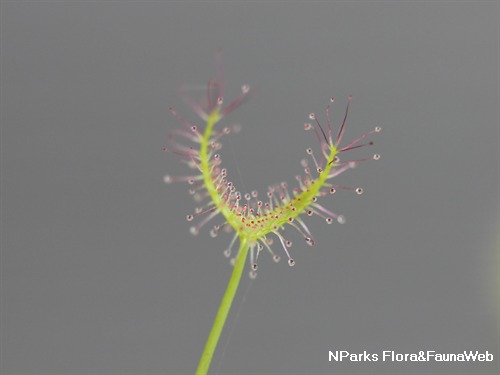
Name
Classifications and Characteristics
| Plant Division | Angiosperms (Flowering Seed Plants) (Dicotyledon) |
|---|---|
| Plant Growth Form | Herbaceous Plant |
| Lifespan (in Singapore) | Perennial |
| Mode of Nutrition | Autotrophic, Heterotrophic (Insectivorous / Carnivorous) |
| Plant Shape | Broad / Mushroom / Hemispherical |
Biogeography
| Native Distribution | Australia |
|---|---|
| Native Habitat | Terrestrial |
| Preferred Climate Zone | Tropical |
| Local Conservation Status | Non-native (Horticultural / Cultivated Only) |
Description and Ethnobotany
| Growth Form | Small herbaceous plant with a fountain-like form. |
|---|---|
| Foliage | The leaf blade is small and round, while the petiole is long and narrow. The leaf blade is densely lined with sticky tentacles bearing mucilage called dew. The dew traps and digests small insects, providing nutrients for the plant. The leaves are arranged in a tight rosette which has a fountain-like form. The petiole or leaf-stalk has whitish hairs known as trichomes which help to trap moisture in the air and increase humidity around the plant. |
| Flowers | Orange flowers are star-shaped and composed of 5 obovate petals. The inflorescence is composed of several flowers that occur on on one side of the inflorescence stalk. |
| Habitat | Occurs in tropical climates with wet-dry seasons and consistently warm temperatures with an average of 30 degrees Celsius that goes up to 40 degrees Celsius or more. During the wet season, there are usually fewer hairs on the petiole than the dry season. During the dry season, the plant may go dormant and the leaves may be replaced by a tuft of hairs. The small-sized leaf blade may be an adaptation to conserve water by reducing the area over which water evaporates and is lost, while the large number of leaves may increase the chance of catching an insect. |
| Similar | This species belongs to a group of about 13 related Drosera species known as the "petiolaris-complex". They all form rosettes and have small, round leaf blades with long, narrow petioles. In nature, members of this group hybridize with one another. Unlike other members of this group, Drosera broomensis does not have hairs on the inflorescence. |
| Cultivation | This species grows well on acidic, nutrient poor media, such as 2 parts peat and 1 part washed sand. |
Landscaping Features
| Desirable Plant Features | Ornamental Foliage |
|---|---|
| Landscape Uses | Container Planting |
| Thematic Landscaping | Carnivorous Garden |
Plant Care and Propagation
| Light Preference | Full Sun |
|---|---|
| Water Preference | Lots of Water |
| Plant Growth Rate | Fast |
| Rootzone Tolerance | Moist Soils, Waterlogged Soils, Poor Infertile Soils, Acidic (low pH) Soils |
| Propagation Method | Seed |
Floral (Angiosperm)
| Flower & Plant Sexuality | Bisexual Flowers |
| Flower Colour(s) | Orange |
|---|
Image Repository
Others
| Master ID | 32887 |
|---|---|
| Species ID | 7301 |
| Flora Disclaimer | The information in this website has been compiled from reliable sources, such as reference works on medicinal plants. It is not a substitute for medical advice or treatment and NParks does not purport to provide any medical advice. Readers should always consult his/her physician before using or consuming a plant for medicinal purposes. |






